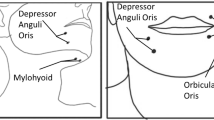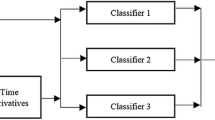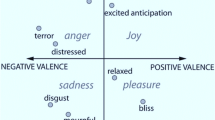Abstract
In this paper, we present a performance comparison of 14 feature evaluation criteria and 4 classifiers for isolated Thai word classification based on electromyography signals (EMG) to find a near-optimal criterion and classifier. Ten subjects spoke 11 Thai number words in both audible and silent modes while the EMG signal from five positions of the facial and neck muscles were captured. After signal collection and preprocessing, 22 EMG features widely used in the EMG recognition field were computed and were then evaluated based on 14 evaluation criteria including both independent criteria (IC) and dependent criteria (DC) for feature evaluation and selection. Subsequently, the top nine features were selected for each criterion, and were used as inputs to classifiers. Four types of classifier were employed with 10-fold cross-validation to estimate classification performance. The results showed that features selected with a DC on a Fisher’s least square linear discriminant classifier (D_FLDA) used with a linear Bayes normal classifier (LBN) gave the best average accuracies, of 93.25 and 80.12% in the audible and the silent modes, respectively.






Similar content being viewed by others
References
Denby B, Schultz T, Honda K, Hueber T, Bilbert J, Brumberg J (2010) Silent speech interfaces. Speech Comm 52(4):270–287. https://doi.org/10.1016/j.specom.2009.08.002
Sugie N, Tsunoda K (1985) A speech prosthesis employing a speech synthesizer vowel discrimination from perioral muscle activities and vowel production. IEEE Trans Biomed Eng 32(7):485–490. https://doi.org/10.1109/TBME.1985.325564
Chan AD, Englehart KB, Hudgins B, Lovely DF (2006) Multiexpert automatic speech recognition using acoustic and myoelectic signals. IEEE Trans Biomed Eng 53(4):676–685. https://doi.org/10.1109/TBME.2006.870224
Kubo T, Yoshida M, Hattori T, Ikeda K (2014) Towards excluding redundancy in electrode grid for automatic speech recognition based on surface EMG. Neurocomputing 134:15–19. https://doi.org/10.1016/j.neucom.2012.12.072
Fraiwan L, Lweesy K, Al-Nemrawi A, Addabass S, Saifan R (2011) Voiceless Arabic vowels recognition using facial EMG. Med Biol Eng Comput 49(7):811–818. https://doi.org/10.1007/s11517-011-0751-1
Lopez-Larraz E, Mozos OM, Antelis JM, Minguez J (2010) Syllable-based speech recognition using EMG. In: Engineering in Medicine and Biology Society (EMBC), 2010 Annual International Conference of the IEEE, Buenos Aires, 31 August-4 September 2010. IEEE, New Jersey, pp 4699–4702. https://doi.org/10.1109/IEMBS.2010.5626426
Jou SCS, Schultz T, Walliczek M, Kraft F, Waibel A (2006) Towards continuous speech recognition using surface electromyography. In: Interspeech 2006-ICSLP, Pittsburgh, 17-21 September 2006
Deng Y, Colby G, Heaton JT, Meltzner GS (2012) Signal processing advances for the MUTE sEMG-based silent speech recognition system. In: MILITARY COMMUNICATIONS CONFERENCE, 2012 - MILCOM 2012, Orlando, 29 October-1 November 2012. IEEE, New Jersey, pp 1–6. https://doi.org/10.1109/MILCOM.2012.6415781
Wand M, Janke M, Schultz T (2014) Tackling speaking mode varieties in EMG-based speech recognition. IEEE Trans Biomed Eng 61(10):2515–2526. https://doi.org/10.1109/TBME.2014.2319000
Betts BJ, Jorgensen C (2005) Small vocabulary recognition using surface electromyography in an acoustically harsh environment. NASA Technical Report. NASA TM-2005-21347, November 2005
Zhou Q, Jiang N, Englehart K, Hudgins B (2009) Improved phoneme-based myoelectric speech recognition. IEEE Trans Biomed Eng 56(8):2016–2023. https://doi.org/10.1109/TBME.2009.2024079
Arjunan SP, Kumar DK, Yau WC, Weghorn H (2006) Unspoken vowel recognition using facial electromyogram. In: Engineering in Medicine and Biology Society, 2006. EMBS’06. 28th annual international conference of the IEEE, Newyork, 30 August-3 September 2006. IEEE, New Jersey, pp 2191–2194. https://doi.org/10.1109/IEMBS.2006.260213
Morse MS, Day SH, Trull B, Morse H (1989) Use of myoelectric signals to recognize speech. In: Proceedings of the 13th Annual Conference of the IEEE Engineering in Medicine and Biology Society, Seattle, 9-12 November 1989. IEEE, New Jersey, pp 1793–1794. https://doi.org/10.1109/IEMBS.1989.96459
Manabe H, Zhang Z (2004) Multi-stream HMM for EMG-based speech recognition. In: Engineering in Medicine and Biology Society, 2004. IEMBS '04. 26th Annual International Conference of the IEEE, San Francisco, 1-5 September 2004. IEEE, New Jersey, pp 4389–4392. https://doi.org/10.1109/IEMBS.2004.1404221.
Bu N, Tsuji T, Arita J, Ohga M (2005) Phoneme classification for speech synthesizer using differential EMG signals between muscles. In: Engineering in Medicine and Biology Society, 2005. IEEE-EMBS 2005. 27th Annual International Conference of the, Shanghai, 17-18 January 2006. IEEE, New Jersy, pp 5962–5966. https://doi.org/10.1109/IEMBS.2005.1615849
Jia X, Wang X, Li J, Yang D, Song Y (2006) Unvoiced Chinese digital recognition based on facial myoelectric signal. In: Communications, Circuits and Systems Proceedings, 2006 International Conference on, Guilin, 25-28 June 2006. IEEE, New Jersey, pp 598–601. https://doi.org/10.1109/ICCCAS.2006.284707
Lyu M, Xiong C, Zhang Q (2014) Electromyography (EMG)-based Chinese voice command recognition. In: information and automation (ICIA), 2014 I.E. international conference on, Hailar, 28-30 July 2014. IEEE, New Jersy, pp 926-931. https://doi.org/10.1109/ICInfA.2014.6932784
Lee KS (2008) EMG-based speech recognition using hidden Markov models with global control variables. IEEE Trans Biomed Eng 55(3):930–940. https://doi.org/10.1109/TBME.2008.915658
Freitas J, Teixeira A, Dias MS (2012) Towards a silent speech interface for Portuguese-surface electromyography and the nasality challenge. In: Proceedings of the International Conference on Bio-inspired Systems and Signal Processing, Vilamoura, 1-4 February 2012. https://doi.org/10.5220/0003786100910100
Topalović M, Damnjanović Đ, Peulić A, Blagojević M, Filipović N (2015) Syllable-based speech recognition using electromyography and decision set classifier. Biomed Eng Appl Basis Comm 27(02):1550020. https://doi.org/10.4015/S1016237215500209
Srisuwan N, Phukpataranont P, Limsakul L (2013) Three steps of neuron network classification for EMG-based Thai tones speech recognition. In: Electrical Engineering/Electronics, Computer, Telecommunications and Information Technology (ECTI-CON), 2013 10th International Conference on, Krabi, 15-17 May 2013. IEEE, New Jersy, pp 1-6. https://doi.org/10.1109/ECTICon.2013.6559639
Phinyomark A, Hirunviriya S, Limsakul C, Phukpattaranont P (2010) Evaluation of EMG feature extraction for hand movement recognition based on Euclidean distance and standard deviation. In: Electrical Engineering/Electronics Computer Telecommunications and Information Technology (ECTI-CON), 2010 International Conference on, Chiang Mai, 19-21 May 2010. IEEE, New Jersy, pp 856–860
Srisuwan N, Phukpataranont P, Limsakul L (2012) Feature selection for Thai tone classification based on surface EMG. Procedia Eng 32:253–259. https://doi.org/10.1016/j.proeng.2012.01.1265
De Luca CJ (2002) Surface electromyography: detection and recording. DelSys Incorporated, pp. 1–10
Clifford GD (2006) ECG statistics, noise, artifacts and missing data. In: Clifford GD, Azuaje F, McSharry P (eds) Advanced methods and tools for ECG analysis. Artech House Publishing, London, pp 55–99
Redfern MS, Hughes RE, Chaffin DB (1993) High-pass filtering to remove electrocardiographic interference from torso EMG recordings. Clin Biomech 8(1):44–48. https://doi.org/10.1016/S0268-0033(05)80009-9
Drake JD, Callaghan JP (2006) Elimination of electrocardiogram contamination from electromyogram signals: an evaluation of currently used removal techniques. J Electromyogr Kinesiol 16(2):175–187. https://doi.org/10.1016/j.jelekin.2005.07.003
Phinyomark A, Phukpattaranont P (2009) A novel feature extraction for robust EMG pattern recognition. J Comput Secur 1(1):71–80
Phinyomark A, Phukpattaranont P, Limsakul C (2012) Feature reduction and selection for EMG signal classification. Expert Syst Appl 39(8):7420–7431. https://doi.org/10.1016/j.eswa.2012.01.102
Liu H, Yu L (2005) Toward integrating feature selection algorithms for classification and clustering. IEEE Trans Knowl Data Eng 17(4):491–502. https://doi.org/10.1109/TKDE.2005.66
Vipin K, Sonajharia M (2014) Feature selection: a literature review. Smart Comput Rev 4(3):211–229. https://doi.org/10.6029/smartcr.2014.03.007
Acknowledgements
We would like to thank the Research and Development Office (RDO), Prince of Songkla University; Associate Professor Seppo Karrila, Faculty of Science and Technology, Prince of Songkla University, Pattani Campus; and Mr. Michal Currie for commenting on the manuscript.
Funding
This work was supported in part by the Thailand Research Fund (TRF) through the Royal Golden Jubilee Ph.D. Program (Grant No. PHD/0164/2552).
Author information
Authors and Affiliations
Corresponding author
Rights and permissions
About this article
Cite this article
Srisuwan, N., Phukpattaranont, P. & Limsakul, C. Comparison of feature evaluation criteria for speech recognition based on electromyography. Med Biol Eng Comput 56, 1041–1051 (2018). https://doi.org/10.1007/s11517-017-1723-x
Received:
Accepted:
Published:
Issue Date:
DOI: https://doi.org/10.1007/s11517-017-1723-x




